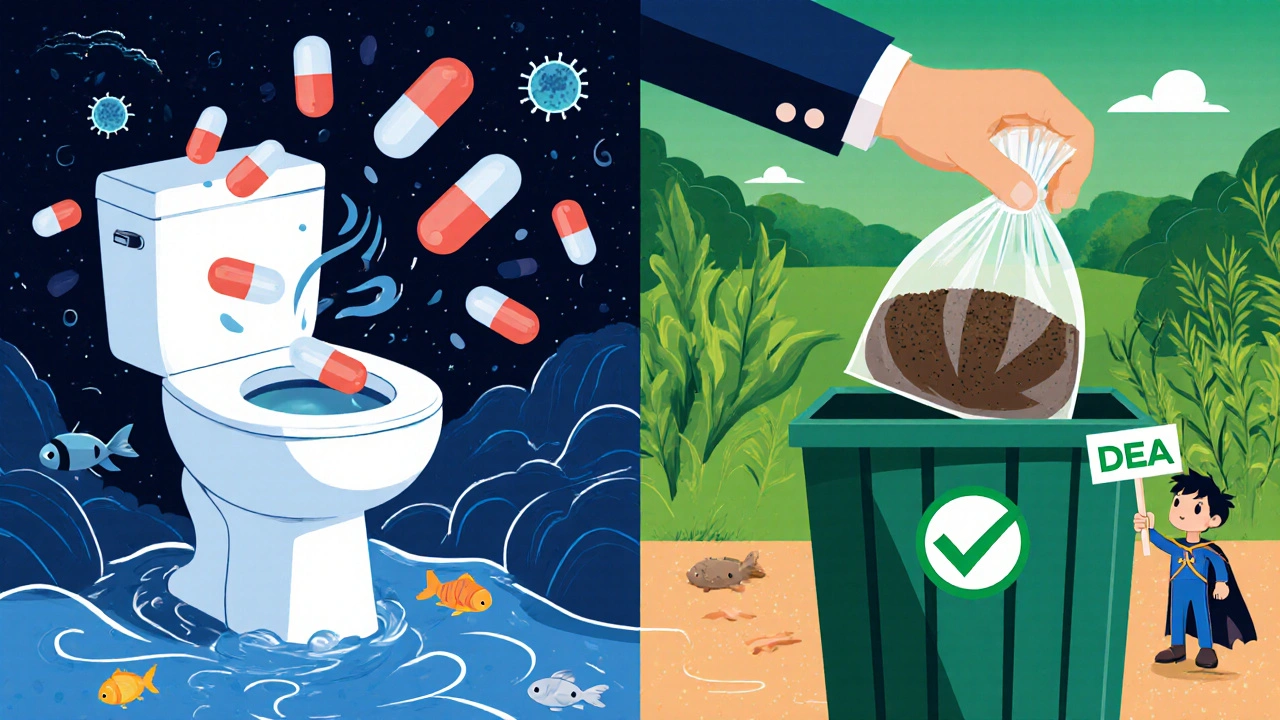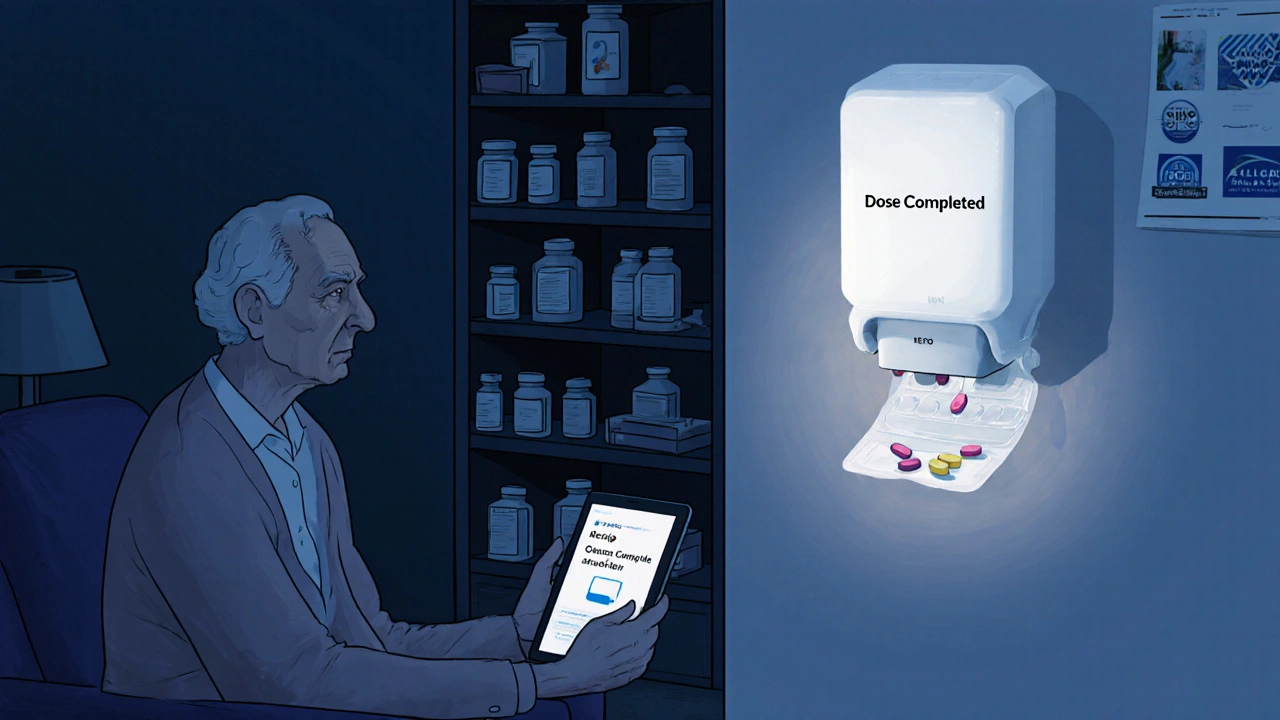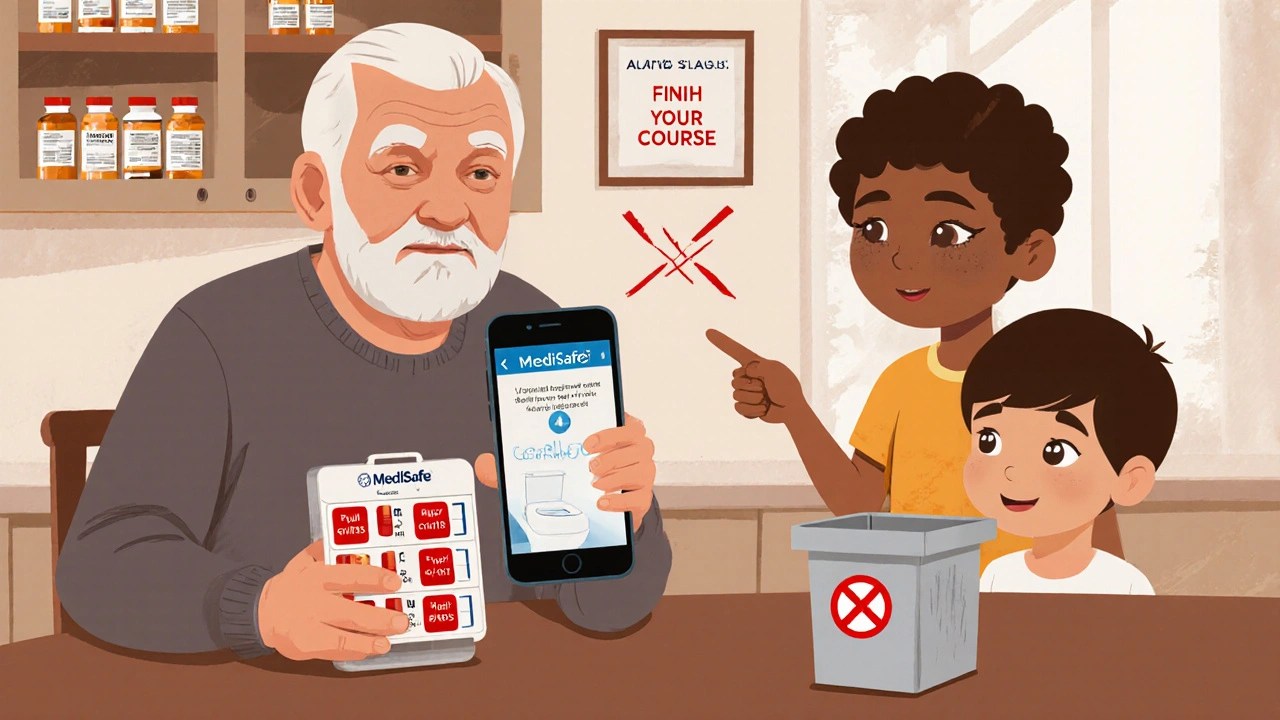Every year, millions of people in the U.S. finish their antibiotics early-because they feel better. They toss leftover pills in the toilet. They save them for next time. They give them to a family member with similar symptoms. None of these seem like big deals. But they are. And they’re making infections harder to treat-for you, your parents, your neighbors.
Why finishing your antibiotic course isn’t optional
You start an antibiotic. Day two: your fever’s gone. Day four: your cough’s gone. So you stop. Seems smart, right? Wrong. Stopping early doesn’t make you healthier-it makes bacteria stronger.
Antibiotics don’t kill all the bad bugs at once. They hit the weakest ones first. The ones that survive? They’re the tough ones. The ones that can resist the drug. When you stop too soon, you leave those survivors behind. They multiply. And now, the next time you get sick, that same antibiotic won’t work.
The CDC says stopping antibiotics early is one of the top three reasons antibiotic resistance grows in homes. A 2022 study from the Infectious Diseases Society of America found people who didn’t finish their course were 23% to 37% more likely to develop a resistant infection. That’s not a small risk. That’s a life-threatening one.
And it’s not just about you. Those resistant bacteria can spread. To your kids. To your elderly parents. To the person you hug after you’ve been sick. Resistance doesn’t care if you finished your pills. It only cares if you left any alive.
How to actually finish your course-without forgetting
Knowing you should finish is one thing. Doing it when you’re tired, confused, or juggling five other meds is another.
Most antibiotics need to be taken every 8 or 12 hours. That means 3 or 2 times a day, on the dot. Miss a dose? You drop the drug level in your blood. Give the bacteria a chance to bounce back.
Here’s what works:
- Pill organizers with alarms-The kind with separate slots for morning, noon, night, and even 2 a.m. These are used by 42% of caregivers who successfully complete courses, according to AALLCare’s 2024 guidelines.
- Smartphone apps-Apps like Medisafe send push notifications, track doses, and even alert family members if a dose is missed. Rated 4.7 out of 5 by over 14,000 users.
- Medication devices like Hero-A $299 smart dispenser that automatically releases pills at set times and texts you if you skip a dose. Subscription is $25/month, but many Medicare Advantage plans cover part of it.
For seniors taking 7+ medications a day, this isn’t a luxury. It’s survival. One Reddit user in Connecticut wrote: "My mom takes 7 meds. Remembering which antibiotic goes at 2 a.m.? Impossible without a system. Now we use a pill box with a loud alarm. She hasn’t missed one in 11 weeks."

What to do with leftover antibiotics-no, not the toilet
You’ve finished your course. There are pills left. What now?
Don’t flush them. Don’t toss them in the trash unopened. Don’t save them for "next time."
Flushing sends antibiotics into waterways. A 2022 study found detectable levels of antibiotics in 63% of U.S. rivers and streams near populated areas. That’s not just pollution-it’s breeding ground for superbugs in the environment.
Keeping leftovers is even more dangerous. The CDC says 61% of people keep unused antibiotics. Then they give them to a friend. Or take them without a prescription. Or use them for a cold. All of that is illegal. All of that fuels resistance.
Here’s what to do instead:
- Use a drug take-back program-Pharmacies, hospitals, and police stations often have drop boxes. Check with your local pharmacy or visit the DEA’s website for locations near you.
- Dispose in household trash (if no take-back is available)-Mix pills with something unappetizing: coffee grounds, cat litter, dirt. Put them in a sealed bag. Throw it in the trash. This makes them unappealing and unusable.
- Don’t crush or dissolve pills-Unless instructed by a pharmacist. Some meds are designed to release slowly. Crushing them can be dangerous.
There’s no perfect solution yet. Only 29% of people know the right way to dispose of antibiotics. But the FDA’s 2022 guidance is clear: if you can’t drop them off, mix and trash. No exceptions.

Why home care is the new frontier of antibiotic resistance
Hospitals have antibiotic stewardship teams. Nurses check doses. Doctors review every prescription. Labs track resistance patterns.
At home? Nothing like that.
Only 12% of home care agencies have formal protocols to check if antibiotics are still needed after 48 hours. In nursing homes? 78% do. That’s a huge gap.
And the people most at risk? Seniors. They make up 34% of home antibiotic users. Many live alone. Many can’t read small print. Many forget names of their meds. A 2023 AARP survey found 38% of seniors don’t complete their courses. And when they don’t? Their hospital readmission rate jumps by 22%.
Family caregivers are the frontline here. But most have no training. The National Alliance for Caregiving says only 31% of family caregivers get any medication safety education. That’s not just a gap-it’s a public health emergency.
What’s changing-and what you can do today
Change is coming. Slowly.
In October 2024, AALLCare released new guidelines specifically for home care of seniors. They say: "Complete the full course, even if the person feels better." And they recommend using reminders, pill boxes, and apps.
The CDC is working on its first-ever Home Care Antibiotic Stewardship Core Elements, due out late 2025. That means formal standards. Training tools. Maybe even funding.
But you don’t have to wait.
Here’s what you can do right now:
- Ask your pharmacist-When you pick up your antibiotic, ask: "How do I know if this is still needed? When should I call back?"
- Set reminders-Use your phone, a pill box, or a simple alarm clock. Don’t rely on memory.
- Dispose properly-No flushing. No saving. Mix with coffee grounds. Trash it.
- Never share-Your antibiotic isn’t their antibiotic. Ever.
- Call your doctor if symptoms return-Don’t use leftover pills. Get a new diagnosis.
Antibiotic resistance isn’t a future threat. It’s happening now. In your kitchen. In your parent’s medicine cabinet. In your neighbor’s sink.
Finishing your course isn’t about following rules. It’s about protecting the next person who gets sick. It’s about making sure antibiotics still work when you-or your child, your grandparent, your best friend-really need them.
That’s stewardship. That’s responsibility. And it starts at home.
What happens if I stop my antibiotic early?
Stopping early leaves behind the toughest bacteria. These survivors multiply and can cause a relapse or a new, harder-to-treat infection. Studies show people who don’t finish their course are 23% to 37% more likely to develop antibiotic-resistant infections.
Can I save leftover antibiotics for next time?
No. Antibiotics are prescribed for a specific infection, at a specific dose, for a specific person. Using old antibiotics for a new illness can be ineffective, dangerous, or even deadly. It also contributes to resistance. Always dispose of unused pills properly.
Is it safe to flush antibiotics down the toilet?
No. Flushing antibiotics pollutes waterways and contributes to environmental resistance. The CDC and FDA recommend mixing unused pills with coffee grounds or cat litter, sealing them in a bag, and throwing them in the trash instead.
How can I remember to take my antibiotic on time?
Use a pill organizer with alarms, a smartphone app like Medisafe, or a smart dispenser like Hero. Set multiple reminders if needed. Ask a family member to check in. Consistency matters more than you think-missed doses lower drug levels and let bacteria survive.
What should I do if I miss a dose?
If you miss a dose by a few hours, take it as soon as you remember. If it’s close to the next dose, skip the missed one and go back to your regular schedule. Never double up. Always check with your pharmacist or doctor if you’re unsure.
Are there programs to help dispose of old antibiotics?
Yes. Many pharmacies, hospitals, and local police stations have drug take-back drop boxes. The DEA offers a searchable map online. If no drop-off is nearby, mix pills with coffee grounds or dirt, seal in a bag, and throw in the trash.
Why is antibiotic resistance a bigger problem at home than in hospitals?
Hospitals have teams that monitor antibiotic use, check for necessity, and track resistance. At home, there’s no oversight. Caregivers often lack training, reminders are missed, and people reuse old prescriptions. This leads to 55% of all inappropriate antibiotic use happening in homes, according to the CDC.
